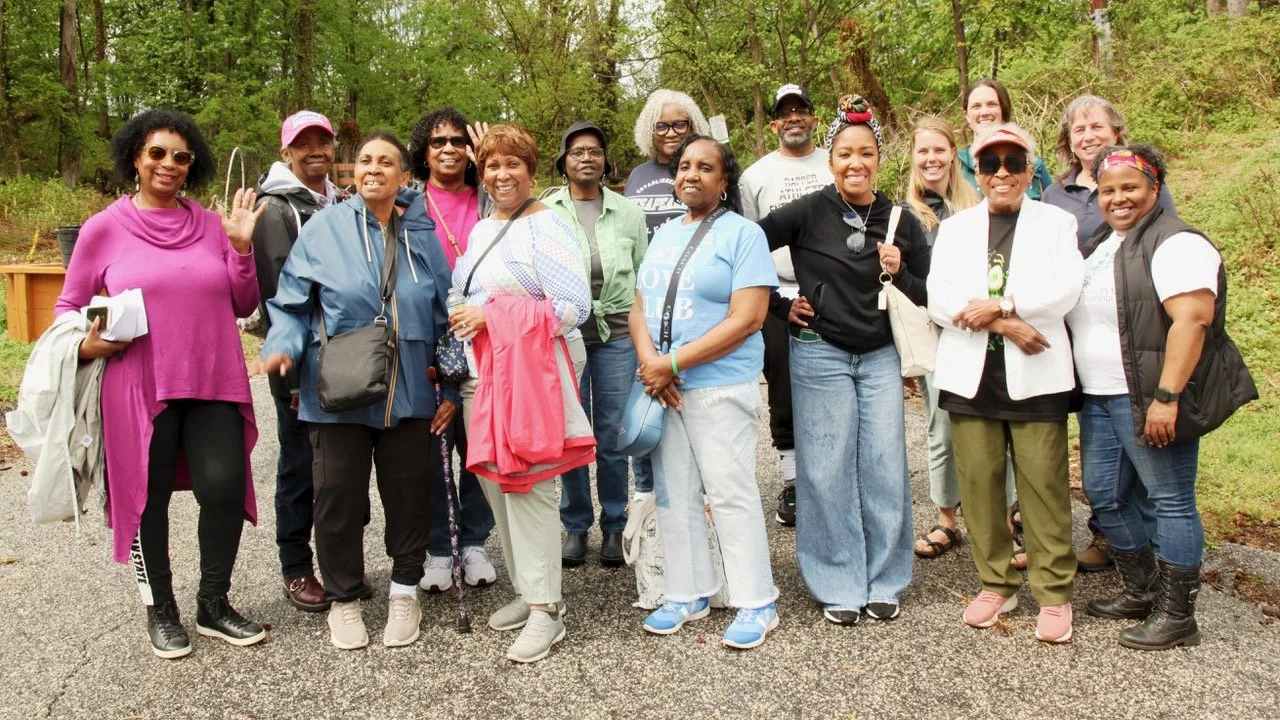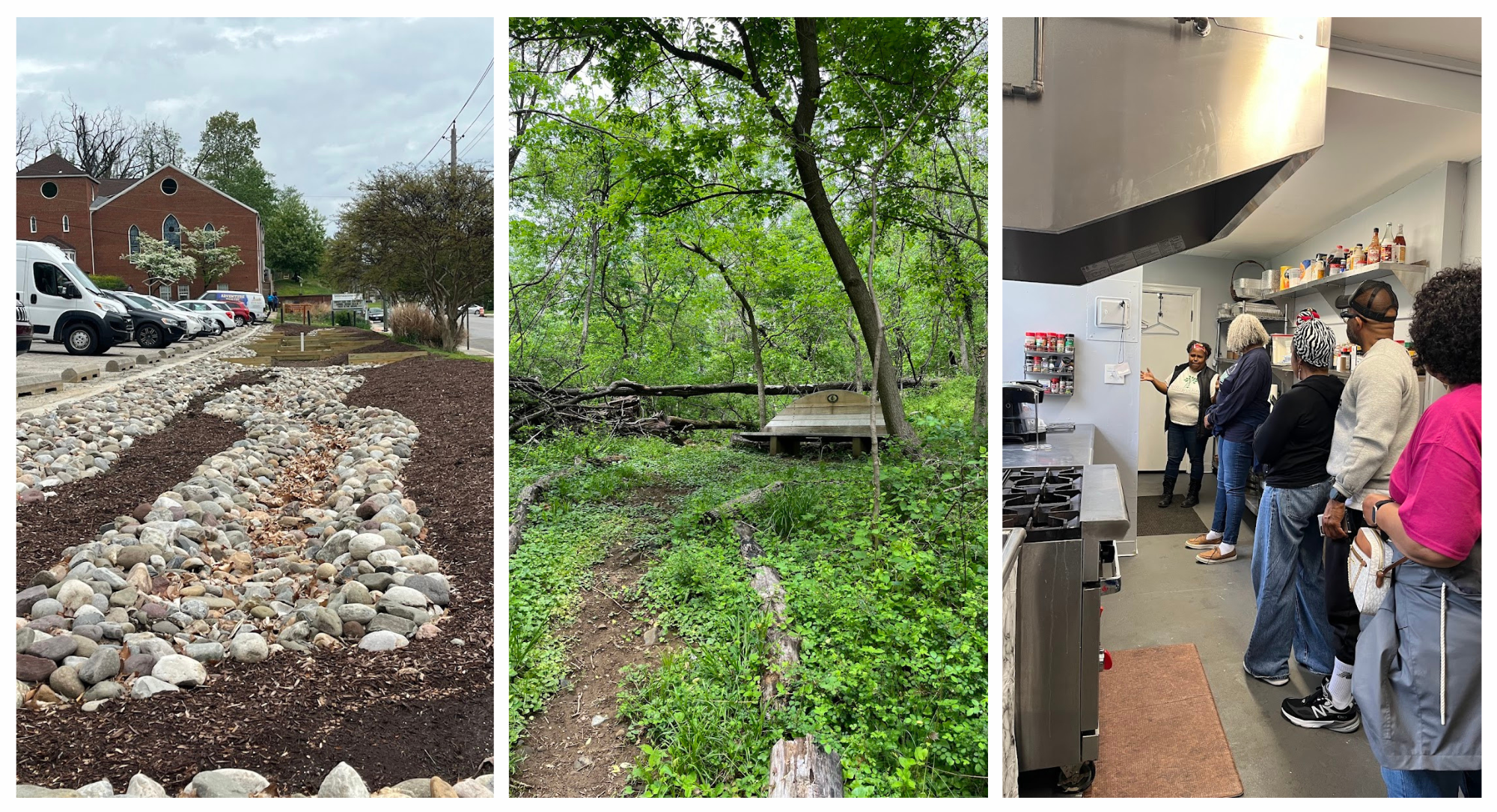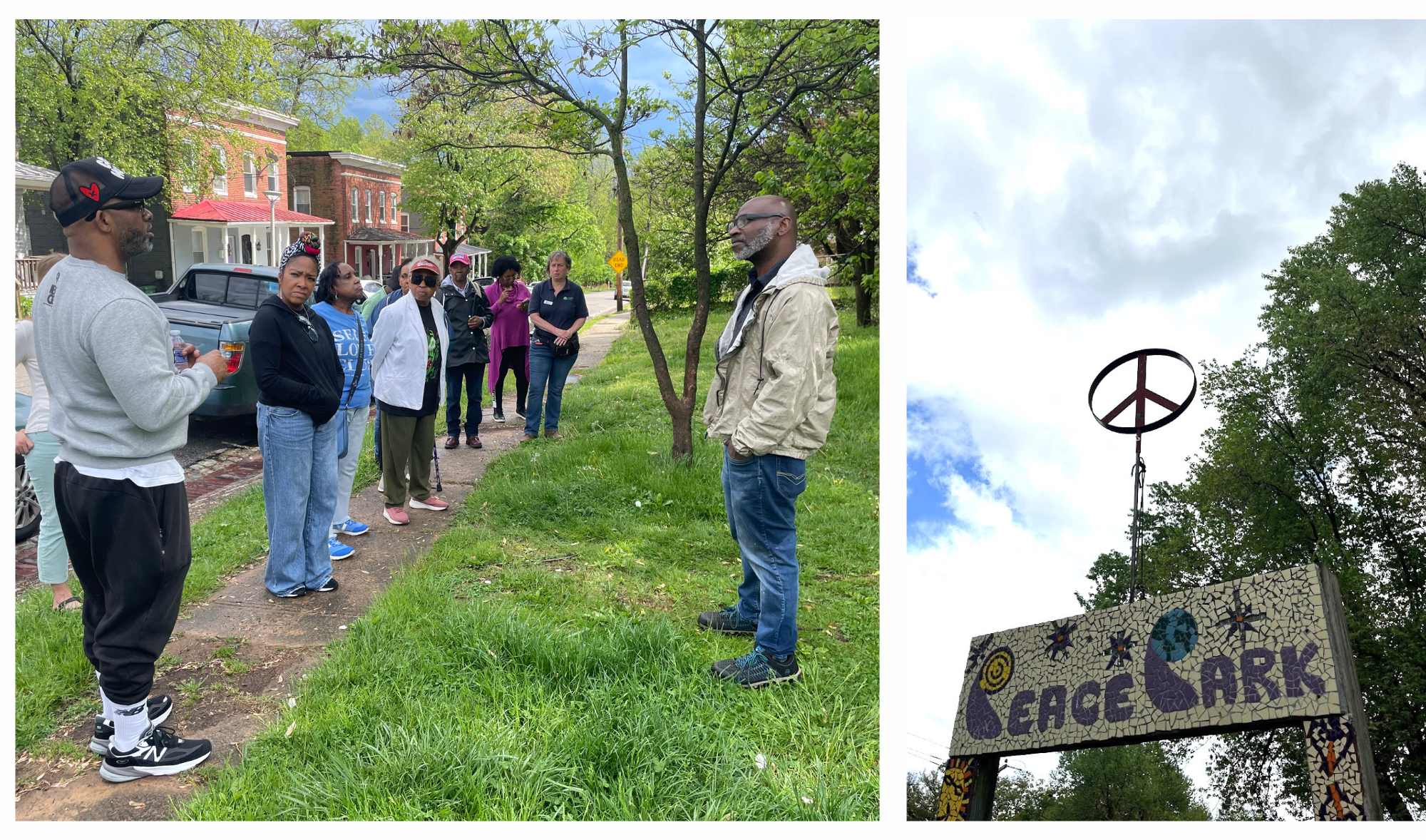When the bus pulled up to Stillmeadow Community Fellowship, the excitement was palpable. Even on a rainy April morning, the group, composed of LEAD the Shore graduates and community ambassadors, was excited to embark on the adventures of the day. They were participating in Envision’s first LEAD 2.0 event, one of a series of field trips and learning opportunities offered to community ambassadors and LEAD the Shore participants to deepen their knowledge of natural resource related issues, further their leadership development, and provide them with the support they need to bring their community visions to life.
LEAD 2.0 participants pose with staff from Envision the Choptank, Stillmeadow Community Fellowship, and Interfaith Partners for the Chesapeake. Photo Credit: Sonia Keiner
Envision the Choptank’s first LEAD the Shore (LEAD) program wrapped up in fall of 2023 with a cohort of 19 graduates from Jonestown and the surrounding areas of Caroline County, Maryland. Developed by Envision’s Engaging Disenfranchised Communities workgroup, LEAD is a leadership development program designed to equip residents of disenfranchised communities with the tools and resources necessary to address the climate change, natural resource, and community development concerns impacting them. As part of the program curriculum, the fall 2023 cohort underwent a community visioning exercise and developed several goals and future projects to pursue. To help advance these goals and resilience efforts, many participants expressed interest in additional LEAD-supported field trips and learning opportunities.
Enter LEAD 2.0, a continuing education program for LEAD graduates interested in deepening their leadership skills and working across communities to advance resiliency. The visit to Stillmeadow Community Fellowship served as the perfect kickoff to this new program, providing an opportunity for a learning exchange with the Baltimore Greater Regional Environmental Equity Network (BGREEN). Similar to Envision the Choptank, BGREEN is a coalition of Baltimore area non-profits and stakeholders committed to helping community partners across Baltimore City and County increase their capacity and resources in order to grow strong, equitable, resilient communities. Stillmeadow Community Fellowship, a BGREEN partner, worked with the coalition to complete a large stormwater resilience project to mitigate extreme flooding challenges on their property. With the success of this project, the group then worked in partnership with BGREEN and Nature Sacred to restore ten acres of forest into a Peace Park, an urban sanctuary replete with trails, benches, meditative spaces, and baptism ponds.
The group has not stopped there. In harmony with their mission, Stillmeadow rose to meet community needs during the COVID-19 pandemic, working to provide food and supplies to neighbors in need. As this project continued to expand, they founded the Stillmeadow Community Projects Resiliency Hub under the capable leadership of Director Yorell Tuck. The group now provides resources related to physical and mental health, housing, food distribution, senior services, internet access, and continues to be a source of support during extreme weather and other emergency situations.
For many of the LEAD participants who also serve as members of the Jonestown Community Development Corporation (JCDC), a community-based non-profit focused on improving the quality of life for Jonestown residents and the surrounding Caroline County area, lessons from Stillmeadow’s latest project proved especially valuable. One of JCDC’s longtime goals (and one prioritized during the LEAD visioning exercise) is the development of a community center and resilience hub through the acquisition and rehabilitation of the former Jonestown School, a building that still stands within the Jonestown community. As the LEAD 2.0 crew toured Stillmeadow, they were able to see a real life example from another community that had brought a similar vision to life. Participants toured the Peace Park, baptism ponds, and resiliency hub, asking questions and sharing their own experiences with the BGREEN partners. The field trip also coincided with City Nature Challenge, an annual science competition hosted at Stillmeadows Peace Park to explore, identify, and document urban plants and wildlife using the iNaturalist app, which demonstrated yet another thoughtful way the space was being activated to serve the greater community.
LEAD 2.0 participants toured Stillmeadow Community Fellowship’s stormwater restoration project (left), Peace Park (center), and resilience hub, which includes a commercial kitchen for community use (right). Photos by Hilary Gibson
After the tour, the group headed inside Stillmeadows for a Community-Based Organization Showcase. This presented a valuable opportunity for exchange and peer-to-peer learning between Envision the Choptank, Jonestown Community Development Corporation, Stillmeadows, BGREEN, and Interfaith Partners for the Chesapeake. Over lunch, the group reflected on what they had seen and learned thus far, what was profound to them, and what pieces they wanted to apply to their own community on the Eastern Shore. BGREEN partners shared encouragement and stories from their journey through creating their community vision, finding resources, connecting with others who share their vision, building trust, rising to meet challenges despite not always feeling completely prepared at the outset, and standing together through all the “no’s” until they got a “yes.”
After lunch, the group piled into the van again and made the short drive over to the Collins Streamside Community to meet with Ulysses Archie, Director of the Baltimore Gift Economy. The Collins Streamside community describes themselves as an “intentional, faith-inspired community, seeking to respond to the wounds inflicted by racism, violence, and environmental degradation.” Residents of this community work together to address concerns related to food security, youth development, and green space. They have co-created a beautiful urban homestead spanning multiple residences, established a Peace Park in a neighborhood vacant lot, and co-host a sustainable food market each week. With an interest in establishing community gardens and building community through intentional spaces, the LEAD participants had a meaningful exchange with Archie, asking him to expand upon his ethos, methods, and process; and sharing about their hopes for Jonestown. Archie offered several anecdotes related to bringing people together to contribute to hands-on projects that benefit the entire community, as well as thinking outside-the-box to meaningfully solve problems.
LEAD 2.0 participants ask questions and share ideas with Ulysses Archie of Collins Streamside Community (left), photo credit: Sonia Keiner. A decorative sign welcomes visitors into the Peace Park (right), photo credit: Hilary Gibson
On the ride home to the Eastern Shore, the group discussed which elements of each project seemed most in alignment with the needs and desires of Jonestown residents. They expressed renewed excitement and motivation toward stepping into leadership positions to accelerate progress on projects in their own community. As the residents of Jonestown continue to work toward the implementation of their shared goals, Envision partners are committed to assisting, sharing resources and information, and empowering residents to leverage their knowledge, skills, unique experiences, and creativity to build a safe, healthy, and resilient community.
Envision the Choptank will be facilitating the LEAD the Shore program in Spring 2026 in Talbot County, MD. The LEAD 2.0 program will continue, as connections and mentorship are fostered between program cohorts.
This program was made possible through funding from the Chesapeake Bay Trust, the Chesapeake Bay Funders Network, Chesapeake Bay Program, National Fish and Wildlife Foundation, U.S. Environmental Protection Agency, and Maryland Department of the Environment.
This project has been funded wholly or in part by the United States Environmental Protection Agency under assistance agreement 96358101 AND 96358201 to National Fish and Wildlife Foundation. The contents of this document do not necessarily reflect the views and policies of the Environmental Protection Agency, nor does the EPA endorse trade names or recommend the use of commercial products mentioned in this document.




